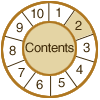
2. Selection
Key Concepts
introduction
legal
restrictions
other criteria
selection policies

INTRODUCTION
Libraries and archives initiate imaging programs to meet real or perceived
needs. The utility of digital images is most likely ensured when the needs
of users are clearly defined, the attributes of the documents are known,
and the technical infrastructure to support conversion, management, and
delivery of content is appropriate to the needs of the project.
LEGAL RESTRICTIONS
Begin your selection process by considering legal restrictions. Is
the material restricted because of privacy, content, or donor concerns?
Is it copyright protected? If so, do you have the right to create and
disseminate digital reproductions? Laura N. Gasaway, Professor of Law
and Director of the Law Library at University of North Carolina at Chapel
Hill, maintains an updated chart
summarizing the terms of protection for published and unpublished works.
Peter Hirtle of the Cornell Institute for Digital Collections has developed
a chart
specifically geared to archival and manuscript curators. Additional information
on copyright in the digital world is available from the Copyright
Management Center at Indiana University-Purdue University Indianapolis,
and from the Copyright
Crash Course at the University of Texas.
For copyright laws pertaining to the UK, TASI provides the "Copyright FAQ" co-developed with the Arts and Humanities Data Service.
The Canadian Heritage Information Network (CHIN) offers several publications via subscription or sale on managing intellectual property.
In Spain the author rights are managed by the Spanish Center of Reprográficos Rights.
Note: we'd like to include good sources on copyright for other countries; if you know of any, please drop us a line.
|
Reality Check My institution is interested in digitizing and making network accessible brittle books published in the United States from 1880-1920. Do we have the legal right to do so? Answer (check one):
|
© 2000-2003 Cornell University Library/Research Department